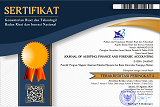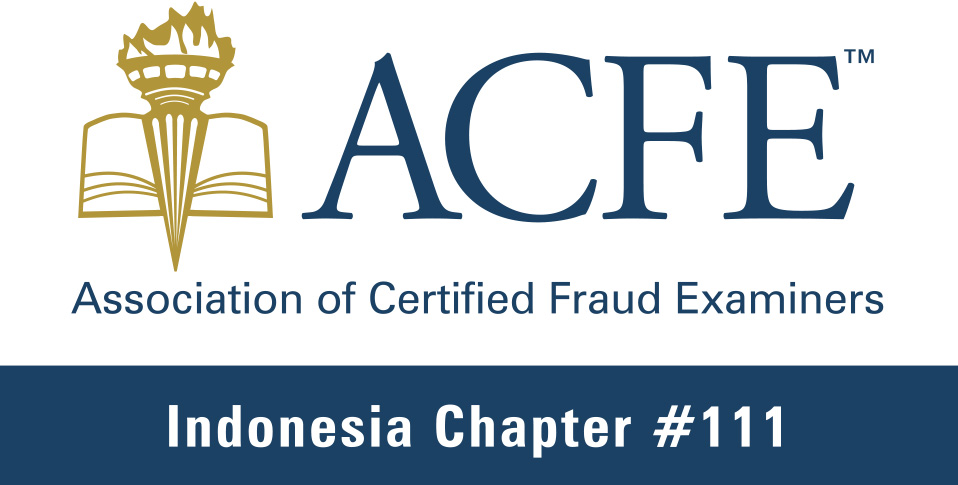Financial Statement Fraud Perspective of Fraud Diamond Theory: Empirical Study on Consumer Cyclicals Sector Companies in Indonesia
Abstract
Keywords
Full Text:
PDFReferences
Abdullahi, R., & Mansor, N. (2015). Fraud Triangle Theory and Fraud Diamond Theory. Understanding the Convergent and Divergent for Future Research. International Journal of Academic Research in Accounting, Finance and Management Sciences, 5(4), 54-64. https://doi.org/10.6007/IJARAFMS/v5-i4/1823.
Abubakar, I. R., Aina, Y. A., & Alshuwaikhat, H. M. (2020). Sustainable Development at Saudi Arabian Universities: An Overview of Institutional Frameworks. Sustainability (Switzerland), 12(19), 1-15. https://doi.org/10.3390/su12198008.
ACFE. (2024). Accupational Fraud 2024: A Report to the Nations. Association of Certified Fraud Examiners.
Achmad, T., Ghozali, I., Helmina, M. R. A., Hapsari, D. I., & Pamungkas, I. D. (2022). Detecting Fraudulent Financial Reporting Using the Fraud Hexagon Model: Evidence from the Banking Sector in Indonesia. Economies, 11(1), 1-17. https://doi.org/10.3390/economies11010005.
Achmad, T., Ghozali, I., & Pamungkas, I. D. (2022). Hexagon Fraud: Detection of Fraudulent Financial Reporting in State-Owned Enterprises Indonesia. Economies, 10(1), 1-15. https://doi.org/10.3390/economies10010013.
Ahmadi, Z., Salehi, M., & Rahmani, M. (2024). The effect of economic complexities and green economy on financial statements fraud. Journal of Financial Crime, 31(2), 267–286. https://doi.org/10.1108/JFC-02-2023-0036.
Akbar, T. (2017). The Determination of Fraudulent Financial Reporting Causes by Using Pentagon Theory on Manufacturing Companies in Indonesia. International Journal of Business, Economics and Law, 14(5), 106–113.
Alves, S. (2023). CEO Duality, Earnings Quality and Board Independence. Journal of Financial Reporting and Accounting, 21(2), 217–231. https://doi.org/10.1108/JFRA-07-2020-0191.
An, B., & Suh, Y. (2020). Identifying Financial Statement Fraud with Decision Rules Obtained from Modified Random Forest. Data Technologies and Applications, 54(2), 235–255. https://doi.org/10.1108/DTA-11-2019-0208.
Aviantara, R. (2023). Scoring the Financial Distress and the Financial Statement Fraud of Garuda Indonesia with «DDCC» as the Financial Solutions. Journal of Modelling in Management, 18(1), 1–16. https://doi.org/10.1108/JM2-01-2020-0017.
Baker, T. A., Lopez, T. J., Reitenga, A. L., & Ruch, G. W. (2019). The Influence of CEO and CFO Power on Accruals and Real Earnings Management. Review of Quantitative Finance and Accounting, 52(1), 325–345. https://doi.org/10.1007/s11156-018-0711-z.
Bawekes, H. F., Simanjuntak, A. M., & Daat, S. C. (2018). Pengujian Teori Fraud Pentagon Terhadap Fraudulent Financial Reporting (Studi Empiris pada Perusahaan yang Terdaftar di Bursa Efek Indonesia Tahun 2011-2015). Jurnal Akuntansi dan Keuangan Daerah, 13(1), 114–134. https://doi.org/10.52062/jakd.v13i1.1429.
Biduri, S., & Tjahjadi, B. (2024). Determinants of Financial Statement Fraud: The Perspective of Pentagon Fraud Theory (Evidence on Islamic Banking Companies in Indonesia). Journal of Islamic Accounting and Business Research. https://doi.org/10.1108/JIABR-08-2022-0213.
Christian, N., Basri, Y. Z., & Arafah, W. (2019). Analysis of Fraud Triangle, Fraud Diamond and Fraud Pentagon Theory to Detecting Corporate Fraud in Indonesia. The International Journal of Business Management and Technology, 3(4), 73–78.
Demetriades, P., & Owusu-Agyei, S. (2022). Fraudulent Financial Reporting: An Application of Fraud Diamond to Toshiba’s Accounting Scandal. Journal of Financial Crime, 29(2), 729–763. https://doi.org/10.1108/JFC-05-2021-0108.
Dewi, K., & Anisykurlillah, I. (2021). Analysis of the Effect of Fraud Pentagon Factors on Fraudulent Financial Statement with Audit Committee as Moderating Variable. Accounting Analysis Journal, 10(1), 39–46. https://doi.org/10.15294/aaj.v10i1.44520.
du Toit, E. (2024). The Red Flags of Financial Statement Fraud: A Case Study. Journal of Financial Crime, 31(2), 311–321. https://doi.org/10.1108/JFC-02-2023-0028.
Fama, E. F., & Jensen, M. C. (1983). Separation of Ownership and Control. Journal of Law & Economics, 26(2), 301–325. http://dx.doi.org/10.1086/467037.
Fitriastuti, A. R., & Umami, M. K. (2021). The Effect of Financial Stability, Industrial Conditions and External Pressures on Fraudulent Financial Statements in Manufacturing Companies Listed on The Indonesia Stock Exchange for the 2019-2020 Period. Islamic Accounting Journal, 1(1), 1–11. https://doi.org/10.18326/iaj.v1i1.1-11.
Hasnan, S., Rahman, R. A., & Mahenthrian, S. (2008). Management Predisposition, Motive, Opportunity, and Earnings Management for Fraudulent Financial Reporting in Malaysia. Malaysian Accounting Review, 7(2), 1–28. http://dx.doi.org/10.2139/ssrn.1321455.
Hidayah, E., & Saptarini, G. D. (2020). Pentagon Fraud Analysis in Detecting Potential Financial Statement Fraud of Banking Companies in Indonesia. UII–ICABE 2019, 89–102.
Jaswadi, J., Purnomo, H., & Sumiadji, S. (2024). Financial Statement Fraud in Indonesia: A Longitudinal Study of Financial Misstatement in the Pre- and Post-Establishment of Financial Services Authority. Journal of Financial Reporting and Accounting, 22(3), 634–652. https://doi.org/10.1108/JFRA-10-2021-0336.
Khamainy, A. H., Ali, M., & Setiawan, M. A. (2022). Detecting Financial Statement Fraud Through New Fraud Diamond Model: The Case of Indonesia. Journal of Financial Crime, 29(3), 925–941. https://doi.org/10.1108/JFC-06-2021-0118.
Khamainy, A. H., Amalia, M. M., Cakranegara, P. A., & Indrawati, A. (2022). Financial Statement Fraud: The Predictive Relevance of Fraud Hexagon Theory. Journal of Accounting and Strategic Finance, 5(1), 110–133. https://doi.org/10.33005/jasf.v5i1.249.
Lastanti, H. S. (2020). Role of Audit Committee in the Fraud Pentagon and Financial Statement Fraud. International Journal of Contemporary Accounting, 2(1), 85–102. https://doi.org/10.25105/ijca.v2i1.7163.
Lizares, R. M. (2022). Ownership Concentration and Board Structure: Alignment and Entrenchment Effects in an Emerging Market. Managerial and Decision Economics, 43(6), 2557-2569. https://doi.org/10.1002/mde.3544.
Mandal, A., & S. A. (2025). Preventing Financial Statement Fraud in the Corporate Sector: Insights from Auditors. Journal of Financial Reporting and Accounting, 23(1), 56-80. https://doi.org/10.1108/JFRA-02-2023-0101.
Maniatis, A. (2022). Detecting the Probability of Financial Fraud Due to Earnings Manipulation in Companies Listed in Athens Stock Exchange Market. Journal of Financial Crime, 29(2), 603–619. https://doi.org/10.1108/JFC-04-2021-0083.
Manry, D., Huang, H.-W., & Yan, Y.-C. (2023). Financial Statement Fraud Litigation, Material Weaknesses, and Board Characteristics. Accounting Research Journal, 36(4/5), 349–368. https://doi.org/10.1108/ARJ-08-2022-0218.
Md Nasir, N. A., & Hashim, H. A. (2021). Corporate Governance Performance and Financial Statement Fraud: Evidence from Malaysia. Journal of Financial Crime, 28(3), 797–809. https://doi.org/10.1108/JFC-09-2020-0182.
Murphy, P. R., & Dacin, M. T. (2011). Psychological Pathways to Fraud: Understanding and Preventing Fraud in Organizations. Journal of Business Ethics, 101(4), 601–618. https://doi.org/10.1007/s10551-011-0741-0.
Nejad, M. Y., Sarwar Khan, A., & Othman, J. (2024). A Panel Data Analysis of the Effect of Audit Quality on Financial Statement Fraud. Asian Journal of Accounting Research, 9(4), 422–445. https://doi.org/10.1108/AJAR-04-2023-0112.
Nguyen Thanh, C., & Phan Huy, T. (2025). Predicting Financial Reports Fraud by Machine Learning: The Proxy of Auditor Opinions. Cogent Business and Management, 12(1), 1-23. https://doi.org/10.1080/23311975.2025.2510556.
Oktarina, D. (2021). Analisis Perspektif Fraud Pentagon pada Terjadinya Kecurangan Akademik Mahasiswa Akuntansi. EKONIKA Jurnal Ekonomi Universitas Kadiri, 6(2), 227-252. https://doi.org/10.30737/ekonika.v6i2.1450.
Oktaviani, N., & Wenny, C. D.. (2023). Fraud Pentagon Dalam Mendeteksi Financial Statement Fraud. MDP Student Conference, 2(2), 36–45. https://doi.org/10.35957/mdp-sc.v2i2.3957.
Omar, N. B., & Mohamad Din, H. F. (2010). Fraud Diamond Risk Indicator: An Assessment of Its Importance and Usage. 2010 International Conference on Science and Social Research (CSSR 2010), 607–612. https://doi.org/10.1109/CSSR.2010.5773853.
Omukaga, K. O. (2021). Is the Fraud Diamond Perspective Valid in Kenya? Journal of Financial Crime, 28(3), 810–840. https://doi.org/10.1108/JFC-11-2019-0141.
Ozcelik, H. (2020). An Analysis of Fraudulent Financial Reporting Using the Fraud Diamond Theory Perspective: An Empirical Study on the Manufacturing Sector Companies Listed on the Borsa Istanbul. Emerald Publishing Limited. https://doi.org/10.1108/S1569-375920200000102012.
Permatasari, D. (2021). Fraud Pentagon sebagai Alat Pendeteksi Financial Statement Fraud: Literatur Review. Jurnal Ilmiah Mahasiswa Ekonomi Akuntansi, 6(4), 546-557.
Putra, M. A., & Achmad, T. (2024). The Influence of Hexagon Fraud Theory on Fraudulent Financial Reporting: The Moderating Role of the Audit Committee. Journal of Ecohumanism, 3(8), 7980–7998. https://doi.org/10.62754/joe.v3i8.5420.
Rahmawati, S., & Susilawati, D. (2019). Pengaruh Dimensi Fraud Diamond Dan Religuisitas Terhadap Perilaku Kecurangan Akademik Mahasiswa. Jurnal Akuntansi Trisakti, 5(2), 269–290. https://doi.org/10.25105/jat.v5i2.4857.
Ramzan, S., & Lokanan, M. (2025). The Application of Machine Learning to Study Fraud in the Accounting Literature. Journal of Accounting Literature, 47(3), 570-596. https://doi.org/10.1108/jal-11-2022-0112.
Rechner, P. L., & Dalton, D. R. (1991). CEO Duality and Organizational Performance: A Longitudinal Analysis. Strategic Management Journal, 12(2), 155–160.
Riskiyadi, M. (2024). Detecting Future Financial Statement Fraud Using a Machine Learning Model in Indonesia: A Comparative Study. Asian Review of Accounting, 32(3), 394–422. https://doi.org/10.1108/ARA-02-2023-0062.
Riskiyadi, M. (2025). Detecting Financial Statement Fraud Using New Ensemble Learning: Evidence During the COVID-19 Pandemic in Indonesia. Journal of Financial Crime, 32(4), 825–842. https://doi.org/10.1108/JFC-08-2024-0264.
Safiq, M., & Seles, W. (2019). The Effects of External Pressures, Financial Targets and Financial Distress on Financial Statement Fraud. Proceedings of the 5th Annual International Conference on Accounting Research (AICAR 2018). https://doi.org/10.2991/aicar-18.2019.13.
Sari, M. P., Mahardika, E., Suryandari, D., & Raharja, S. (2022). The Audit Committee as Moderating the Effect of Hexagon’s Fraud on Fraudulent Financial Statements in Mining Companies Listed on the Indonesia Stock Exchange. Cogent Business and Management, 9(1), 1-23. https://doi.org/10.1080/23311975.2022.2150118.
Seifzadeh, M., Rajaeei, R., & Allahbakhsh, A. (2022). The Relationship Between Management Entrenchment and Financial Statement Fraud. Journal of Facilities Management, 20(1), 102–119. https://doi.org/10.1108/JFM-02-2021-0026.
Situngkir, N. C., & Triyanto, D. N. (2020). Detecting Fraudulent Financial Reporting Using Fraud Score Model and Fraud Pentagon Theory: Empirical Study of Companies Listed in the LQ 45 Index. The Indonesian Journal of Accounting Research, 23(3), 373–410. https://doi.org/10.33312/ijar.486.
Skousen, C. J., Smith, K. R., & Wright, C. J. (2009). Detecting and predicting financial statement fraud: The effectiveness of the fraud triangle and SAS No. 99. Advances in Financial Economics, 53–81. https://doi.org/10.1108/S1569-3732(2009)0000013005.
Skousen, C. J., & Twedt, B. J. (2009). Fraud in Emerging Markets: A Cross Country Analysis. Cross Cultural Management: An International Journal, 16, 301–316.
Smaili, N., Arroyo, P., & Issa, F. A. (2022). The Dark Side of Blockholder Control: Evidence from Financial Statement Fraud Cases. Journal of Financial Crime, 29(3), 816–835. https://doi.org/10.1108/JFC-05-2021-0113.
Solichin, M., Sanusi, Z. M., Johari, R. J., Gunarsih, T., & Shafie, N. A. (2022). Analysis of Audit Competencies and Internal Control on Detecting Potential Fraud Occurrences. Universal Journal of Accounting and Finance, 10(1), 171–180. https://doi.org/10.13189/ujaf.2022.100118.
Soltani, M., Kythreotis, A., & Roshanpoor, A. (2023). Two decades of financial statement fraud detection literature review; combination of bibliometric analysis and topic modeling approach. Journal of Financial Crime, 30(5), 1367–1388. https://doi.org/10.1108/JFC-09-2022-0227.
Tessema, A. M., Zahir-Ul-Hassan, M. K., & Ahmed, A. (2024). Corporate Governance, Earnings Management and the Moderating Role of Political Connections: Evidence from the Gulf Co-Operation Council Countries. International Journal of Ethics and Systems. https://doi.org/10.1108/IJOES-02-2024-0056.
Vousinas, G. L. (2019). Advancing Theory of Fraud: the S.C.O.R.E. Model. Journal of Financial Crime, 26(1), 372–381. https://doi.org/10.1108/JFC-12-2017-0128.
Widharma, F., & Susilowati, E. (2020). Auditor Switching, Financial Distress, and Financial Statement Fraud Practices with Audit Report Lag as Intervening Variable. Journal of Accounting and Strategic Finance, 3(2), 243–257. https://doi.org/10.33005/jasf.v3i2.135.
Wolfe, D. T., & Hermanson, D. R. (2004). The Fraud Diamond: Considering the Four Elements of Fraud. CPA Journal, 74(12), 38–42.
Yesiariani, M., & Rahayu, D. I. (2016). Analisis Fraud Diamond dalam Mendeteksi (Studi Empiris pada Perusahaan LQ-45 yang Terdaftar di Bursa Efek Indonesia tahun 2010–2014. Simposium Nasional Akuntansi XIX, 1–22.
Yuniasih, N., Muliati, N., Putra, C., & Dewi, I. (2020). The Effect of Pressure to Financial Statement Fraud (Study of Manufacturing Companies Listed on The Indonesian Stock Exchange). Proceedings of the Proceedings of The First International Conference on Financial Forensics and Fraud, ICFF, 13-14 August 2019, Bali, Indonesia. https://doi.org/10.4108/eai.13-8-2019.2294390.
DOI: https://doi.org/10.21107/jaffa.v13i1.29412
Refbacks
- There are currently no refbacks.
Our Journal indexed by:
Our support tools using:



This work is licensed under a Creative Commons Attribution 4.0 International License.












